Physical Address
304 North Cardinal St.
Dorchester Center, MA 02124
Well - differentiated tumors of the CNS with mature neurons (ganglion cells) as a defining feature: includes ganglioglioma (ganglion cell tumor with a low-grade glial element), gangliocytoma (without a glial element), and anaplastic ganglioglioma (ganglion cells and anaplastic glial elements)
4% of primary brain tumors, ~0.2/100,000/year
Most common in temporal lobe, but may arise throughout neuraxis
More common in children, but can be seen in any age group
Associated with seizures; location-dependent symptoms
Most are benign (WHO Grade I)
Rare anaplastic types are WHO Grade III
Most treated with surgery only (>90% 10-year survival)
Occasionally to recur; extremely rare to metastasize within neuraxis
May combine surgery, radiation for inoperative or anaplastic (WHO III) variants
Variably enhancing solid or cystic tumor (sometimes with enhancing nodular component)
May be calcified
Demarcated or discrete tumor mass; with or without cystic changes or calcifications
Disorganized collection of mature ganglion cells with variable glial background
Clusters of mature neurons, with large nuclei, prominent nucleoli in disordered/haphazard arrangements
Ganglion cells may exhibit binucleation or have bizarre-appearing nuclei
Rosenthal fibers, eosinophilic granular bodies commonly present
Perivascular lymphocytes, microcalcifications also can be present
Must evaluate glial component for anaplasia (mitoses, microvascular proliferation, necrosis)
Perineuronal “satellitosis” usually absent
Synaptophysin, chromogranin, neurofilament reactive neoplastic ganglion cells
Neuronal nuclear antibody is typically negative in neoplastic ganglion cells
GFAP-positive in astrocytic elements
Ki-67/MIB1 usually low, <2%
Glial neoplasms: pilocytic astrocytoma, diffuse astrocytoma entrapping cortical neurons
Dysembryoplastic neuroepithelial tumor (DNET)
Developmental lesions
Cortical dysplasia
Tuberous sclerosis
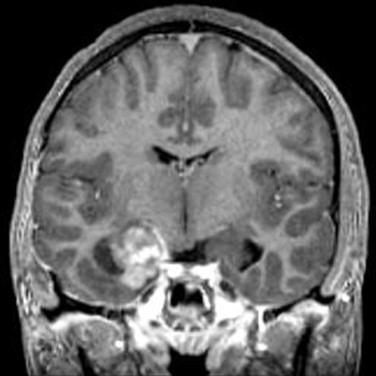
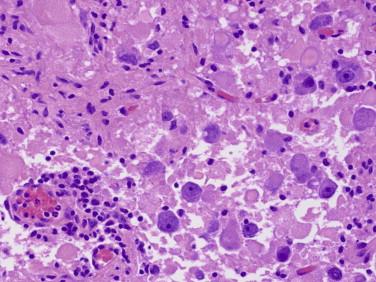
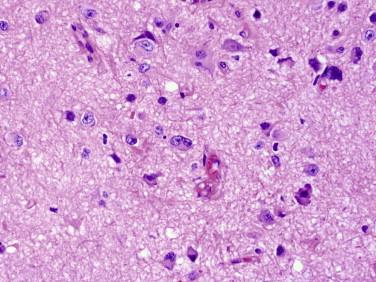
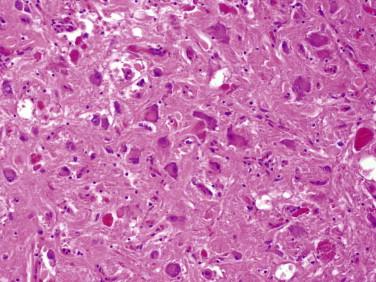
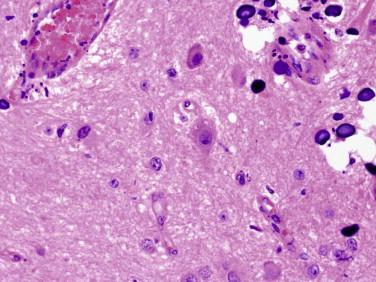
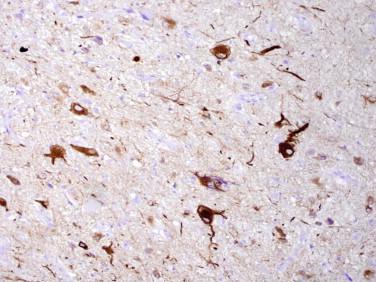
Benign neoplasm, but often massive, brain tumor of infancy with glial (desmoplastic infantile astrocytoma, DIA) or neuronal (desmoplastic infantile ganglioglioma, DIG) elements
<1% of primary brain neoplasms
Tumors of infants; majority <2 years of age
Roughly equal gender distribution
Supratentorial, usually frontoparietal and superficial (often with meningeal involvement)
Compressive symptoms with hydrocephalus, bulging fontanelles, vomiting
May have seizures, nerve palsies, spasticity
WHO Grade I—benign: good prognosis, rare craniospinal seeding or metastases
Treatment: complete resection; residual disease may remain static or regress
Large cystic hemispheric mass with internal solid enhancing nodule(s), commonly attached to dura
Demarcated, large (>10 cm), cystic tumor with rubbery solid areas
May involve multiple lobes
Noninfiltrative tumor composed of spindled astrocyte-like cells
Small ganglion cells also seen in the DIG
Storiform pattern with desmoplastic reticulin-rich stroma
Foci of primitive and mitotically active cells may be present without implications for aggressive behavior
Frequently spread along Virchow-Robin spaces
Reticulin (invests tumor cells)
Astrocytic cells strongly immune reactive for GFAP
Ganglion cells are synaptophysin, NeuN, neurofilament, and neuron-specific enolase positive
Low Ki-67 index <2%
Become a Clinical Tree membership for Full access and enjoy Unlimited articles
If you are a member. Log in here